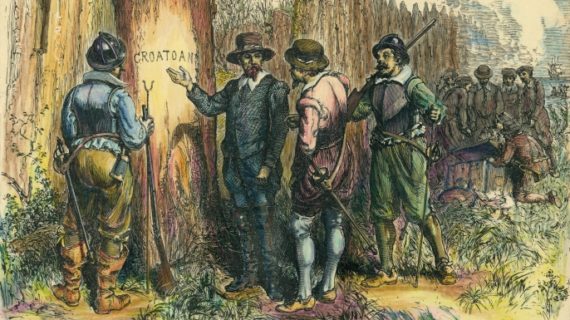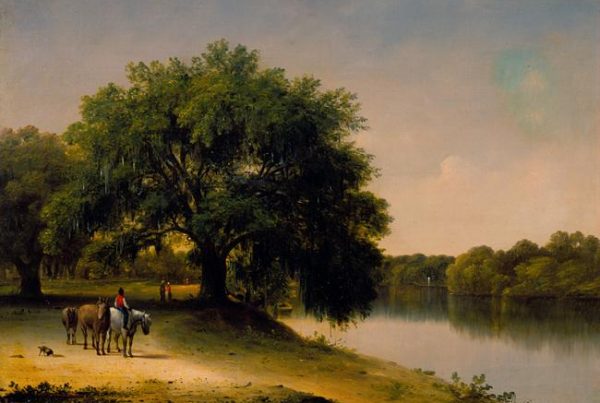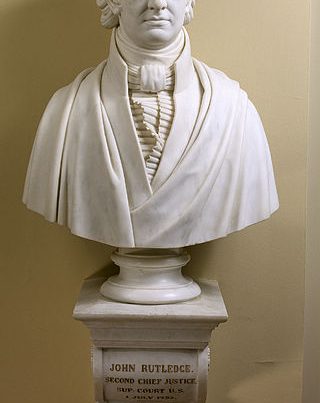Citizens of Dixie…. This is a call to arms, or rather, a call to your legs and feet. Get up off that couch! If you don’t have family plans, ballgame, school play, or church event- get out and tour Dixie! Take a few hours, a day, or a weekend, and see the beauty and history of Dixie.
Start local; tour houses, museums, historic sites and take in the natural beauty of Dixie! Keep your money local, travel byways and visit ‘mom and pop’ establishments. As Brion McClanahan says, “Think locally, act locally!” Celebrate Dixie and let everyone know you are celebrating Dixie!!!
Why not start where the story of English colonization of America began. Between the North Carolina mainland and the Outer Banks, lies Roanoke Island. Here, in 1584, the first English settlement in America was founded. Fort Raleigh National HIstoric Site and Museum is a good place to start. (Sir Walter Raleigh was one of the backers of the colony) Stroll the nearby Elizabethan Gardens. The Outer Banks History Center and Roanoke Maritime Museum offer more local flavor. The Roanoke Island Festival Park has a kid- friendly museum, 16th Century replica ship, and American Indian village. Try out some of the local seafood and take the family on a Pirate Adventure of the Outer Banks. The Lost Colony outdoor drama has been performed every summer since 1937 in Manteo. What better way to end your exploration of Roanoke Island. The fate of the colony may never be known, but new information is surfacing and visiting these sites can be very rewarding for the historical detective.
Several historic towns, integral to the early history of North Carolina, dot the rivers which empty into Albermarle and Pamlico Sounds. We move next to Elizabeth City on the Pasquotank River. Check out the Museum of the Albermarle or relax with some waterfront dining. The Albermarle Region Paddling Trails offer canoe and kayak opportunities. This area saw Culpeper’s Rebellion in 1677 as a result of attempted enforcement of the Navigation Acts and weak, sometimes corrupt, government. A few miles southwest on US 17 crosses the Perquimans River near Hertford. A short distance off the highway is the oldest house in North Carolina, the Newbold-White House. The house was probably built by Joseph Scott in the 1660’s and was the site of early colonial assemblies and even Quaker religious services.
Explorers from the Jamestowne Colony in Virginia first explored the area around Edenton, just off the Chowan River. Settled in 1712 as “the Towne of Queen Anne’s Creek,” it was incorporated in 1722. An early colonial capital of North Carolina, Edenton was named for Gov. Charles Eden. The historic district features many architectural gems. The Georgian-style Chowan County Courthouse (1767) sits on a beautiful village green.The Cupola House (c.1725) is perhaps the best known house in town. The Iredell House (1776, 1816) was home of patriot and Supreme Court Justice (appointed by George Washington) James Iredell. St. Paul’s Episcopal Church, begun in 1736, is one of the oldest churches in the state. The Thomas and Penelope Barker House (c.1782) Welcome Center is a great place to start your visit to Edenton. Penelope Barker was involved in The Edenton Tea Party, a protest of the Tea Act which was organized by local women in support of the First Provincial Congress. A declaration was signed by 51 women and sent to the British press. The women said that men had led the protest up till that point, and it was time for women to make their voices heard. They signed their names, so the British would know who they were, and did not hide their identities like those at the Tea Party in Boston. It is amazing that this event is not a well known story in the colonial fight for liberty!
Our next port of call is Plymouth, on the Roanoke River. The Moratuc had a village in this vicinity, on the river which they called Moratuc. Though English had explored the area much earlier, Arthur Rhodes founded Plymouth in 1787, on a part of his Brick House plantation. The Port O’Plymouth History Museum and Roanoke River Maritime Museum provide an introduction to area history. Of particular interest is the War to Prevent Southern Independence (WTPSI) history of Plymouth. Captured by Federal forces in 1862, control of the Albermarle Sound hurt the Confederate cause. Yet Federals were unable to capture Ft. Branch further up the Roanoke River near Hamilton, and cut the railroad between Wilmington and Richmond. The Wilmington & Weldon was a major Confederate supply line, and the longest railroad in the world when completed in 1840. Ft. Branch also protected the construction of the Confederate ram CCS Albermarle. In April, 1864, a combined force of Confederate infantry under Gen. Hoke and the CSS Albermarle attacked and retook Plymouth.
U.S. Highway 64 to the east will take you back to Roanoke Island, our starting point. Seven miles off this highway below Creswell is Somerset Place (c.1830) A Greek Revival style mansion, it sits on the shore of Phelps Lake, the second largest natural lake in the state. The tour of the grounds includes the only interpreted slave hospital in the country. Remnants of a canal cut through the swampy countryside towards the Scuppernong River, and a connection to the outside world. The Collins family never recovered from the devastation of the WTPSI, and the estate fell into disrepair until restoration efforts began in the 1950’s.
Starting back at Plymouth, we go a few miles southwest , where the Tar River enters the Pamlico River estuary, lies the city of Washington, founded in 1776. The first city named for George, it is often called The Original Washington or Little Washington to differentiate it from that other swamp. Burnside’s expedition led to Federal control of Washington during the WTPSI. A Confederate siege in spring of 1863 failed to retake the town. Few historic buildings survived the 1864 fire caused by Yankee occupation. Take a walk on the boardwalk at the North Carolina Estuarium or along the docks of this important Revolutionary War port. Enjoy a river cruise on the Belle of Washington.
A few miles downriver, Bath Creek empties into the Pamlico. Historic Bath is the state’s oldest town, founded in 1705 by John Lawson, explorer and chronicler of Carolina. St. Thomas Episcopal Church (1734) is the state’s oldest. Home to 3 early governors, Bath almost became the colony’s capital. Perhaps its most famous inhabitant was the pirate Blackbeard, villain, swashbuckler, patriot…..the story of the Knight of the Black Flag continues to develop as research brings new sources to light. Another interesting story connected with Bath is Edna Ferber’s book Showboat, which was turned into a musical. She spent several days on the James Adams Floating Theatre in 1925, gathering material and inspiration from the company.
Backtracking to Washington, we cross the Pamlico River and follow U.S. 17 to New Bern, at the confluence of the Neuse and Trent Rivers. North Carolina’s second oldest town, it was named for Berne, Switzerland by Swiss and German immigrants in 1710. The restored colonial Tryon Palace was the Georgian-style home of royal governors and after the Revolution, the capital of the independent state of North Carolina. Enjoy a tour featuring period furnishings and beautiful gardens, and imagine the history this ground has witnessed. Nearby historic homes include the Dixon House (c.1830), the Robert Hay House (c.1805) and the (c.1783)John Wright Stanly House(and yes, Washington did sleep here!) Watch the reenactment of the Sept. 5, 1802 duel between political rivals. Take a haunted, candlelight tour of the Attmore-Oliver House (c.1790), which is also home of the New Bern Historical Society. Founded in 1715, Christ Episcopal Church is the third oldest in North Carolina. Take a carriage tour of the historic downtown, and view the city as noblemen and patriots did. Look back at 150 years of firefighting in the New Bern Fireman’s Museum. It was the first chartered fire department in the state. Check out stories of the great fire of 1922 when 1,000 homes were destroyed. Just South of town is the site of the Battle of New Bern. Gen. Burnside sought to capture New Bern as part of his effort to control the sounds and ports of the Carolina coast. Confederate forces had constructed significant earthworks, but did not have the manpower to hold them. Outnumbered, and with many poorly trained militia, their lines were broken and New Bern fell with their retreat.
Following U.S. 70 southeast from New Bern brings us to the coast at Morehead City and Beaufort. Incorporated in 1722, Beaufort is North Carolina’s 3rd oldest city. The North Carolina Maritime Museum is a great place to learn of explorers, pirates, merchants, warships, shipwrecks….the maritime history of the region, which was important in the West Indian Trade. The Beaufort Historic Site in the heart of the historic district, features several historic homes which tell the story of this early port. The Carteret County Courthouse (c.1796) has recently been restored. The John C. Manson House (c.1825), the Josiah Bell House (c.1825) and Samuel Leffers Cottage (c.1778) are examples of the homes of historic community leaders. The Old Burying Ground dates back to 1731. Guided tours, living history and special programs offer enriching educational opportunities.
Nearby Morehead City offers more educational experiences at the History Museum of Carteret County. The annual North Carolina Seafood Festival, held the first weekend in October is an eagerly anticipated event. It also has donated almost $ 2 million dollars to local nonprofits in the past 30 years.
The Outer Banks, North Carolina’s barrier islands, offer many attractions-beaches, seafood, lighthouses, aquariums, wildlife and beautiful ocean views. The preservation of dunes, salt marshes, and wildlife is ongoing, and many institutions as well as state and federal parks are integral in this effort. Opposite Beaufort, near Atlantic Beach, sits Ft. Macon. Attempts to protect Beaufort from pirates and foreign warships had not resulted in a permanent fort at the entrance to Beaufort Inlet. Ft. Macon was begun in 1826, and Robert E. Lee helped design a system for erosion control in the 1840’s. North Carolina Confederate forces captured the fort in April, 1861. The Union offensive in eastern North Carolina in 1862 led to the surrender of the fort after a bombardment by rifled artillery. Ft. Macon was the second masonry fort to fall to the new type of artillery. The area remained in Union control for the remainder of the war.
Just up the coast is Cape Lookout National Seashore. The Cape Lookout Lighthouse, 163 foot high, is the second lighthouse on this site at the southern end of the Outer Banks. Confederates removed lenses to keep Union ships from using this navigation aid. Later, after Union forces controlled the area and it was again in service, Confederate troops attempted to blow it up. After the war, the lenses were found in Raleigh, and replaced. The lighthouse is reached by ferry, which departs from Harkers Island, just east of Beaufort. The ferry is near the Harkers Island Visitor Center and the Core Sound Waterfowl Museum and Heritage Center.
A good map and some planning will help you navigate the highways, ferries and bridges that connect the Out Banks. Moving north, we come to Ocracoke Island, and then Hatteras. Cape Hatteras National Seashore features 210 foot tall Cape Hatteras Lighthouse, completed around 1870. It is the tallest brick lighthouse in the United States. The nearby Graveyard of the Atlantic Museum will give the visitor an idea of why the lighthouse was so necessary.
Pea Island National Wildlife Refuge and Bodie Island bring us back to the vicinity of our Roanoke Island starting point. The Bodie Island Lighthouse is 158 feet tall and was completed in 1872, and overlooks Roanoke Sound. A few miles further up the beach, just past Nags Head, is the Wright Brothers National Memorial at Kitty Hawk, site of Wilbur and Orville’s first successful powered airplane flight.
Water trails on many of the waters of Eastern North Carolina offer opportunities for outdoor recreation. Preserving the sand dunes, pocosin wetlands, estuaries and rich wildlife of this region is an ongoing process, involving many local, state, and federal agencies. Black bear, red wolves, American alligators, deer are among the animals inhabiting this region, along with many species of waterfowl.
From Virginia Dare to the Wright Brothers, Blackbeard, James Iredell, and Penelope Barker….the history and heritage of Eastern North Carolina is told in museums, historic sites, and local festivals. Experience history with a stay at a local bed and breakfast. Check out local cuisine, farmer’s markets, arts and crafts. Cultural events abound, and you can take home memories and souvenirs.







